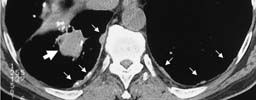- AI
- Molecular Imaging
- CT
- X-Ray
- Ultrasound
- MRI
- Facility Management
- Mammography
Occupational lung diseases pose serious dilemmas
Coughing, shortness of breath, chest pain, chest tightness, and an abnormal breathing pattern are common indications of lung disease. The question is which one?
Coughing, shortness of breath, chest pain, chest tightness, and an abnormal breathing pattern are common indications of lung disease. The question is which one?
The list of likely diagnoses may well include a number of occupational lung diseases (OLD), depending on the patient's history. But how many city-based radiologists have ever seen a case of farmer's lung? And would practitioners based in rural areas think of considering coalworkers' pneumoconiosis?
Knowledge of a patient's exposure to inhaled matter can certainly help when initially diagnosing OLD, but diagnoses are not always straightforward. Take, for example, the case of a patient whose imaging examination reveals a singular pleural plaque. If that patient had previously worked with asbestos-containing materials, can a diagnosis of asbestos-related pleural disease be made? Or is the patient's occupational history merely coincidental and the abnormal finding indicative of an entirely unrelated lung condition?


A special focus session provided insight into the diagnostic dilemmas associated with OLD from a clinical and a radiological perspective. Leading experts in the field also presented the latest approaches to classifying OLD using semiquantitative and quantitative methods.
Diseases caused by repeated, long-term exposure to inhaled irritants are referred to as pneumoconioses. The most common are asbestosis, silicosis, and coalworkers pneumoconiosis, which develop following repeated exposure to asbestos, silica (quartz), and coal dust. Less common pneumoconioses include bird fancier's lung, due to the inhalation of proteins contained in bird droppings and feathers, and byssinosis, a condition linked to cotton, flax, and hemp fibers.
Imaging evaluations of OLD have traditionally been performed using chest radiography. CT is now increasingly used as well to improve the accuracy of diagnoses and identify early signs of disease.
"For the last century, we have known that working with silica and dust hurts the lungs. With multislice CT, we may be able to diagnose these changes at an earlier stage," said Prof. Dr. Gerhard Mostbeck, a professor of radiology at the Wilhelminenspital and Otto Wagner Hospital and Medical Centres in Vienna, who chaired the session.
Clinical tests, such as lung function assessments, are often unable to detect the first signs of OLD, said Dr. Kurt Hering, a radiologist at the Knappschafts-Hospital in Dortmund, Germany. Consequently, CT can be a useful surveillance tool.


"If you only have small pleural changes and no parenchymal changes, then the patient's lung function will not be disturbed. These changes will only be shown on high-resolution radiological images," he said.
Guidance for classifying pneumoconioses from chest radiographs has been provided by the International Labour Office (ILO) since 1950. The latest guidance, ILO-2000, is accompanied by two sets of standard radiographs showing typical opacities and pleural abnormalities. The sets include some composite images made up of quadrants from full-size radiographs to highlight key findings. Debate is ongoing about the technical quality of some of these reference images, which were acquired years ago.
A second classification system, for use with high-resolution CT, is now available as well. The International Classification for Occupational and Environmental Respiratory Diseases (ICOERD) was developed by experts from seven countries, in response to requests for a more standardized approach to CT-based diagnosis. As with the ILO-2000 scheme, radiologists have access to a series of reference images.
Hering shared the podium with Dr. Karina Hofmann-Preiß, a private practice radiologist in Erlangen, Germany. One topic that usually generates discussion is how to perform the HRCT examination, Hering said. High-resolution thin slices are essential when looking for signs of pneumoconiosis. Unenhanced CT examinations are preferred to avoid the side effects of the contrast medium and difficulties differentiating contrast-filling vessels from pleural plaques.
Despite legislation to improve industrial working conditions, European radiologists may see a steady increase in asbestosis cases over the next 10 or 20 years, Hering said. This is due to the time lag between asbestos exposure and the development of related conditions.
"The incidence of bronchal carcinoma related to asbestos exposure and mesothelioma is going up year on year. It is therefore necessary that radiologists are familiar with these findings," he said.
Can a CT-Based Radiomics Model Bolster Detection of Malignant Thyroid Nodules?
May 3rd 2024A computed tomography (CT)-based radiomics model that includes 28 radiomic features showed significantly higher accuracy, sensitivity, and specificity than conventional CT in differentiating benign and malignant thyroid nodules, according to newly published research.
European Society of Breast Imaging Issues Updated Breast Cancer Screening Recommendations
April 24th 2024One of the recommendations from the European Society of Breast Imaging (EUSOBI) is annual breast MRI exams starting at 25 years of age for women deemed to be at high risk for breast cancer.
